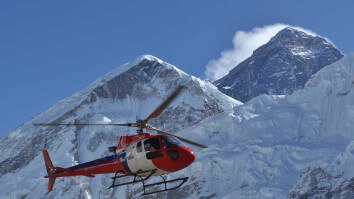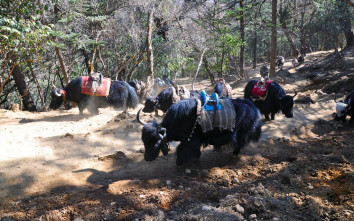Where is Mount Everest Located?
28th Dec, 2023
- himalayaheart

Where is Mount Everest on the World Map?
Mount Everest, the highest peak in the world, is located in the majestic Himalayas. Situated on the border between Nepal and Tibet (China), Mount Everest is a prominent landmark that has captivated adventurers, climbers, and nature enthusiasts for decades. Let's explore the location of Everest in Nepal, its geographical features, how to reach it, the climate you can expect, the best time to visit from Kathmandu, and some interesting facts about this incredible mountain.
Table of Contents
Where is Mount Everest Located?
Mount Everest, known in Nepali as Sagarmatha and in Tibetan as Chomolungma, stands as a beacon for adventurers, climbers, and nature enthusiasts around the world. Its majestic peak, reaching skyward at 8,848 meters (29,029 feet), is not only the highest point on Earth but also a symbol of human perseverance and the awe-inspiring power of nature. In this blog post, we delve into the geographical and cultural significance of Mount Everest, aiming to provide comprehensive insights into its location, accessibility, and the surrounding region's rich cultural heritage.
The Geographical Location of Mount Everest
Mount Everest is situated in the Mahalangur range of the Himalayas, straddling the border between Nepal and the Autonomous Region of Tibet, China. The mountain's exact coordinates are 27.9881° N latitude and 86.9250° E longitude. This location places it in the northeastern part of Nepal and the southern part of Tibet, making it a pivotal landmark for both countries.
Mount Everest: On the Border of Nepal and Tibet
The unique positioning of Mount Everest means it can be accessed from both Nepal and Tibet. The southern approach, which is more commonly used by climbers, begins in Nepal and involves trekking through the Khumbu Valley to reach the mountain's base camp. Conversely, the northern approach starts in Tibet and offers a different perspective of Everest, albeit with different challenges and requirements, including the need for permits from the Chinese government.
Climbing Routes and Base Camps
Mount Everest has two main base camps: the South Base Camp in Nepal at an altitude of 5,364 meters (17,598 feet) and the North Base Camp in Tibet at 5,150 meters (16,900 feet). These base camps are the starting points for climbers attempting to reach the summit via the southeast ridge from Nepal or the northeast ridge from Tibet, respectively. Each route has its own set of challenges, historical milestones, and breathtaking vistas.
Everest base camp is one of the most famous trekking destinations in the world.
The Cultural Significance of Mount Everest
Mount Everest is deeply ingrained in the cultural fabric of both Nepal and Tibet. For the Sherpa people and Tibetans, Everest holds spiritual significance and is often associated with the goddess Miyolangsangma, who is believed to reside at the top of the mountain. The respect and reverence for the mountain are evident in the rituals and prayers performed by climbers and locals alike, seeking blessings for a safe journey.
Why Mount Everest Attracts Climbers and Tourists
The allure of Mount Everest goes beyond its status as the highest peak in the world. For many, it represents the ultimate challenge and a testament to human endurance. Climbers are drawn to its slopes for the opportunity to stand at the top of the world, while tourists visit the region to witness its breathtaking beauty, experience the unique culture of the Himalayas, and embark on treks that offer spectacular views of the mountain and its surroundings.
The Environmental and Ecological Importance of Everest
Mount Everest plays a critical role in the ecology of the Himalayas, influencing climate patterns and serving as a habitat for unique flora and fauna. The conservation efforts in the region aim to protect its delicate ecosystem and ensure that future generations can continue to marvel at this natural wonder.
Preserving the Majesty of Mount Everest
As Mount Everest continues to attract climbers and tourists from around the globe, the importance of sustainable practices and environmental stewardship becomes ever more critical. Efforts by both Nepali and Tibetan authorities, as well as international organizations, focus on preserving the beauty and integrity of Everest and its surroundings, ensuring that it remains a source of inspiration and awe for many years to come.
Mount Everest, with its imposing height and profound cultural significance, remains one of the most fascinating and revered natural landmarks in the world. Whether viewed from a distance or experienced up-close, it continues to captivate the imagination and spirit of all who behold it.
Recent From Blog


























